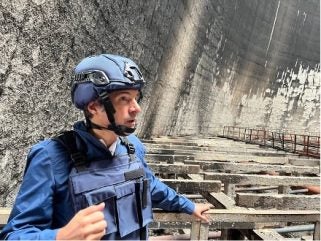
Following talks in Kyiv, IAEA Director General Rafael Mariano Grossi and his team crossed the frontline again to visit the Zaporizhia NPP (ZNPP). “As I conduct my fifth visit to the ZNPP, and my tenth to Ukraine since the beginning of the conflict, I want to reassure the international community that the IAEA, and I as Director General, will continue to do everything possible within our mandate to assist in averting a nuclear or radiological accident at any of Ukraine’s nuclear facilities,” he said.
Earlier, IAEA noted that ZNPP, located on the frontline of the conflict, had suffered eight complete loss of power events during the conflict, forcing it to temporarily rely on diesel generators. “Just this week, the plant … lost its connection to its sole remaining 330 kilovolt (kV) back-up power line, leaving it dependent on one single 750 kV line,” the Agency said.
“I think the situation I have very often characterised it as very fragile,” Grossi told reporters before he left Kyiv. “The station is again on the verge of being on a blackout. We’ve had eight of those in the past. A blackout (means) no power: no power, no cooling. No cooling, then maybe you have a disaster.” Earlier, Grossi posted on X that he was on his way to Zaporizhia to “help prevent a nuclear accident”.
Grossi’s visit was conducted alongside a regular rotation of the agency’s specialists stationed at ZNPP. “Together with Grossi, a new 23rd team of inspectors, consisting of four people, arrived at the station, which will replace the previous one,” ZNPP said on its Telegram channel. The previous rotation took place on 6 August. “We are happy to be here. This is our fifth visit. Time shows us the importance of our cooperation. Of course, we still have difficulties,” Grossi said.
The visit was covered by a large group of Russian journalists who were present at Grossi’s talks in the station and visit to various facilities on site. These included the cooling tower which was the subject of a huge fire on 11 August. While ZNPP reported that this was caused by a Ukrainian drone strike, Ukrainian officials had said it was cause by Russia burning tyres at the base of the tower.
REN TV reported that the IAEA delegation, to examine the damage, had to “climb a high rusty staircase into a huge smoke-blackened chimney”. The inspection wasn’t cursory,” the report added. “As a result, everyone expected some conclusions from the IAEA Director General, but he was very careful in his remarks.”
Grossi noted: “At least we were clearly convinced that the fire was not at the base of the cooling tower, I know that the investigation is still ongoing. As the station director informed me, it is deeper to clarify the causes of the fire. We agreed that we will continue to discuss this situation until we are notified of the final result,”
Russian media reported that, while Grossi admitted that there was no arson inside the cooling tower, he did not say anything about the origin of the attack drones. Nevertheless, “the station staff was grateful to him”. ZNPP Director Yuriy Chernichuk, who accompanied Grossi while he was at the plant, noted: “We are waiting for the most important thing – ensuring security so that there are no arrivals in the area of the station, and Mr Grossi contributes to this as much as possible.”
Grossi was quoted by Izvestia as saying: “It was very important for us and for me personally to get first of all an idea of the situation and the dramatic events of August 11, the fire on the first cooling tower of the station. We were also able to see all the work that was carried out on the plant’s water pump system and fuel storage.”
Later, in an interview with Rossiya 1 TV, Grossi said: “The fire did not start at the base of the cooling tower. There was outside interference. The investigation is still ongoing. We still need to clarify the causes of the fire. And we agreed that we will continue to discuss this situation until there is a final result.” He added: “This situation shows that we must be constantly ready until the conflict is over. The possibility that something serious may happen cannot be ruled out.”
Tass reported him as saying: “It is clear that the situation is frightening because of the military actions. I was informed that even today there was shelling of territories nearby. We are here to show the situation, to provide information about what is happening here to the entire world community. Give an unbiased assessment.”
Meanwhile, Rosatom Director General Alexey Likhachev said after Grossi’s visit that Russia will continue to ensure that the perpetrators of the attacks on ZNPP are identified. He urged the IAEA not to be afraid to tell the truth about provocations at the NPP.
“The IAEA continues to request additional information in order to clearly identify the source of these threats. We believe that we need to go further. We must not be afraid to tell the truth, to determine where we are coming from, who is delivering ammunition and drones in order to strike at the territory of the Zaporizhia nuclear power plant.”
He told reporters that the positions of Rosatom and the IAEA regarding the assessment of sources of threats to the NPP are still at odds. “Where do our positions continue to differ? In the absence of an assessment of the culprits, in determining the causes and authors of those threats, the results of which can generally be seen with the naked eye,” he said.
The Permanent Representative of the Russian Federation to the international organizations in Vienna, Mikhail Ulyanov, made a similar point on his X page. “Today, IAEA Director General Grossi made his fifth successful visit to the ZAES. Will this help the agency better identify who is behind regular attacks on the station? I doubt it, to be honest.”
During Grossi’s visit to Ukraine and ZNPP, the IAEA issued a new report on the challenges and achievements of the Agency’s activities to protect ZNPP (see related story).






